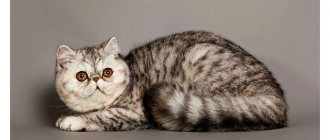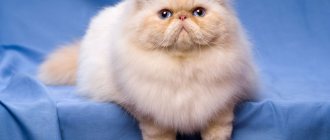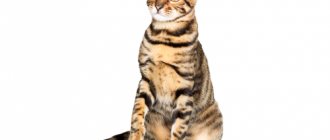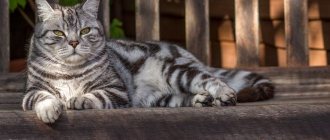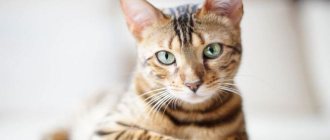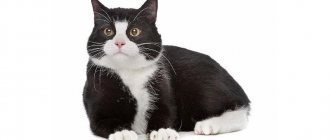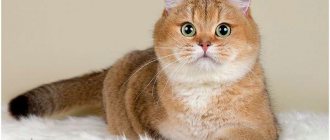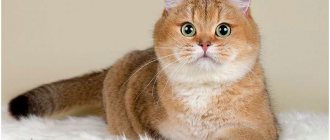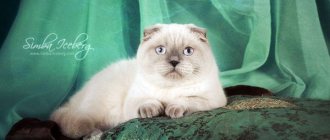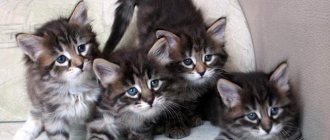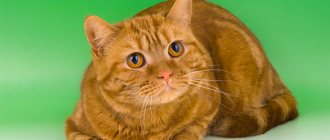Origin of brindle cat breeds
The cat family belongs to a group of mammals from the order Carnivora; they live all over the world. Domestication and artificial breeding of new breeds pleases us with the presence of a pet with an unusual color at home. A prerequisite is dark stripes and spots reminiscent of the coloring of a tiger, leopard or jaguar. Color - from yellow and sandy to dark brown. The body structure is reminiscent of predatory species of wild cats - a long tail, small paws, a head with a wide nose and a thin elongated body with a powerful neck. Miniature tiger.
Purebred breeds of brindle cats are bred only in official nurseries. On average, an adult weighs from 6 to 9 kg.
By the way, our domestic Siberian cat with thick fur that hides the true pattern is directly related to tiger cats. The weight of an adult pet reaches 12 kg. Very loyal to its owner.
Savannah
A relatively new breed that was recognized by the Cat Fanciers' Association in 2012, the Savannah is known for its unusual appearance. Large, tall ears are located on the top of the head. The savanna is also characterized by a long neck, long legs and a short, thick tail. In addition, these cats have exotic spotted and striped coats. And this is not surprising, the wild appearance of the savannah was achieved by crossing the African serval with a domestic cat.
Conclusion about the breed
In a wild, wild forest lives a wild, wild cat... This is not a fairy tale about toygers, because only those who are not at all familiar with the breed can call these graceful animals wild. Toyger is good-natured like Winnie the Pooh and funny like Piglet.
The only thing they have in common with tigers is their balance - toygers do not rush around the house headlong, but lie majestically, accepting gifts and admiration. Mischief is also not their strong point; they take advantage of their friendliness and ability to get along with adults and children.
If there are no adults or children nearby, the toyger will not go into depression, but will continue to lie majestically, awaiting the gifts and admiration that, sooner or later, will certainly be given to him.
His intelligence is quite enough to learn where in the house the tray is and where the bowl is, and nothing more is required from the mini-tiger.
Toygers themselves are also unpretentious and fit into the interior of any income.
Since the breed is young, experts have not yet identified hereditary diseases and, God forbid, they will not identify it later.
Asian tabby
The brindle pattern is found among both short-haired and long-haired felines.
The Asian tabby cat is an animal with an exotic tiger color. The color of the coat can reach gray and silver shades, not at all reminiscent of its predatory counterpart. The formation of kittens' coloration can take from several weeks to two to three months. Purchasing an expensive friend is only possible at a specialized breeding farm upon pre-order.
The cost of a pet depends on the pedigree history, color contrast and characteristic pattern. Belonging to a certain class determines the final price. Pet class with differences from the standard color is estimated at 15-30 thousand rubles, Brit class with minimal errors in the standard - from 30-40 without the right and up to 60-70 thousand with the right to further breeding. Show class is a brindle cat with an ideal pattern and the right to breed. It costs from 80 thousand.
Where to buy and how much does a kitten cost?
There are several official nurseries in Russia.
Toyger kitten
The most famous:
- "Greencity" (Zelenograd);
- "Moscow Family" (Moscow);
- "FAIRY BERENDEY" (Moscow);
- "Wild Jungle" (Istrinsky district).
Mini-tigers are also sold by private individuals. However, when buying a baby from a nursery, a person receives a guarantee of his health and breed.
What to pay attention to
When choosing a kitten, pay attention to its appearance and behavior. The baby must be clean, active, not afraid of people and sit calmly in the breeder’s arms.
The website of a reliable nursery must indicate the names of the systems (TICA, ICU) in which it is registered.
Serious breeders give kittens long names consisting of the name of the nursery and nickname. Additionally, the details of the father and mother must be indicated. It is recommended to familiarize yourself with the pedigree of the parents.
Approximate cost of a kitten
The Toyger is a rare and expensive breed.
The cost of a kitten depends on its class:
- pet class - 70-80 thousand rubles;
- Brit class - 150 thousand rubles;
- show class – 200 thousand rubles.
Nurseries sell adult cats for a nominal fee. They are given away when, due to age, the animal ceases to be a producer.
There are advertisements on the Internet for the sale of kittens from private individuals. Their cost is lower, but they are not suitable for participation in exhibitions and breeding.
Toyger. Description
An elite of cats, ideally similar to the powerful "big brother". The name comes from the word "tiger". The Toyger breed was developed by selective breeding by mating a Bengal cat and an outbred Indian cat. It has the perfect transverse stripes characteristic of tiger skin. Representatives of the breed have the muscular build of a wild cat and weigh up to 7–8 kg, while cats weigh up to 5 kg. The animals have a wide chest and strong legs, perfect color contrast.
Reproduction in nurseries of this breed is strictly controlled by the owner. The toyger was officially recognized in 2007; the animals are considered rare and valuable. You can buy a kitten for a price of 1 to 2 thousand dollars (approximately 65-130 thousand rubles) depending on the color received at birth. Catteries sell pre-sterilized felines for home keeping. Selection work to breed the ideal miniature domestic tiger continues.
Interesting Facts
Although representatives of the Toyger breed appeared recently, a lot of interesting things have already happened to them:
- The name of this variety of tabby cats fully justifies their appearance and consists of two English words: toy - “toy” and tiger - “tiger”.
- Toygers are one of the few cats that have no fear of water. “Domestic tigers” are not afraid of bathing and perceive it as a standard hygiene procedure.
- Representatives of the breed become sexually mature at 5 months. But physically and psychologically, toygers are formed only by the age of two.
Find out also what other cat breeds are similar to a tiger.
What to feed?
Tabby cats cannot stand monotony in their food. You cannot feed such a cat with dry food alone. You need to regularly change the type of meat, alternating, for example, chicken with beef and fish. Otherwise, the owner risks throwing the cat's lunch in the trash and being left alone with a hungry predator.
The diet must include fresh meat, live food, mineral and vitamin supplements.
The issue of nutrition is fundamental in keeping animals. The diet should be selected depending on the breed, taking into account the advice of experts.
- The toyger has good health and experts do not give any special recommendations for feeding it. It is sometimes recommended to offer solid food to prevent dental disease.
- Bengal cats also have good health, their life expectancy is up to 15 years. Such expensive animals, as a rule, are fed either high-quality natural products - fish, meat, or expensive cat food with vitamins.
- Tender Sokoke are advised to be kept on a balanced diet with vitamin E and taurine, as their heart and metabolism may be weak.
- Mau often suffer from allergies, asthma and heart problems, so they especially need special food for this breed. If your cat has a tendency to these ailments, be sure to feed your pet correctly.
- Posh Ashers are recommended to be given natural products - high-quality beef, poultry, ocean fish, and leave dry food as an additive to the rest of the diet.
- American Shorthair cats love to eat, so that this does not lead to problems, it is recommended to feed them twice a day, and not on demand. Don’t forget to occasionally pamper them with dietary boiled meat, they love it very much.
- If you take up keeping munchkins, then depending on their age, experts advise feeding them 2 to 5 times a day: kittens - more often, and older animals - less often. Babies who are only a few months old are advised to give cereals, dairy products, meat, while adults can be switched to regular food, wet or dry.
- Siberian cats can be very large, and it is important to correctly calculate the amount of food. Typically, 30-60 grams of feed are given per 1 kg of weight. To make the coat look beautiful and shiny, up to 3 years of age, a diet containing 70% protein is recommended.
Approximate prices for tiger kittens
A kitten of any of the above breeds is considered a great luxury. Due to the low birth rate, striped animals are quite expensive. The price depends on the breed and starts from 60,000 rubles.
| Breed | Cost, rub. |
| Toyger | 60 000-200 000 |
| Oncilla | 140 000 |
| Bengal cat | 70 000 |
| Asian tabby | 70 000 |
| Sokoke | 60 000 |
| Savannah | 500 000 |
| Egyptian Mau | 100 000 |
| Asherah | 150 000-1 500 000 |
Tiger cats are exotic and quite expensive animals. They require special care and will make excellent companions for those who are willing to provide them with the appropriate conditions.
Sokoke. Description of the breed and its representatives
Medium sized Sokoke cat with marbled tabby pattern on a sandy background. The ears are large with tassels. The slanted look gives an original expression to the face of the graceful representative of the Kenyan forests. Sokoke is the forest African ancestor of Asian cats. The breed was registered in 1993. A distinctive feature of the tiger cat's coloring is the presence of a necklace around its neck. The color of the skin, similar to the bark of a tree, makes it distinguishable from other subspecies.
A miniature copy of a cheetah has a restless character and irrepressible energy. Strong attachment to the owners and playfulness will make the pet unhappy if its owners are constantly absent or busy with work. Sokoke is ready to play around the clock, which is suitable for families with small children. Hide and seek, chasing and constant movement around the apartment are what an active animal needs. African origin makes itself felt with the onset of cold weather, which is difficult for this heat-loving breed to tolerate.
Character and temperament
Toygers are balanced, friendly, trusting and obedient cats with a carefree, sociable disposition. “Domestic tigers” easily get used to people and are not afraid of strangers. Cats of this breed adore their owners and do not tolerate loneliness well.
Toygers get along well with children and love to play with them. True, parents must control that children do not offend the “pet tiger.”
Toyger cats get along well with other pets, especially if they grew up with them. Due to the muted but present hunting instinct, “domestic tigers” will not be able to make friends with small rodents and ornamental birds.
On a note. Toygers need close communication with their owners and persistently demand attention. This trait is especially pronounced in young representatives of the breed. With age, the character of tabby cats stabilizes, and they become much calmer.
Pixie bob
To develop a breed of cat that resembles a lynx, breeders used short-tailed forest cats. These animals live in the forests of North America. The first cat obtained in this way was named Pixie, which means “Elf” or “Fairy” in English.
The animals are distinguished by a short tail, tufts on the ears and whiskers are possible. Pixies are unpretentious, train well and easily make contact with people.
Relationships of the Toyger breed to other animals
The toyger is not considered a breed that has retained hunting instincts, but it is unlikely that he will be able to make friends with a canary or hamster. The animal will consider the smaller inhabitants of the house as just another toy designed to brighten up the cat’s loneliness.
When walking, the toyger must be kept on a harness. Otherwise, the cat can easily get into a fight with the dogs or run away, becoming interested in a new object.
Bengal and Egyptian Mau
The Bengal breed was the result of artificial mating of a wild leopard cat with outbred Californian cats in 1963. The breed was registered in 1983 and is more common than the Toyger.
Egyptian Mau are spectacular cats with short hair and slender legs, with the grace of a queen and large eyes. The four subspecies include smoke and silver with black spots, honey and sand with brown leopard patterns.
When a sacred pet died in ancient Egypt, it was buried with honors in the family crypt or in a separate animal cemetery. The embalmed feline was accompanied to another world by mummified mice.
British and American breeds
The brindle color of the British cat attracts many breeders. Representatives of this breed have an obstinate character and the appearance of a fabulous Cheshire cat. The animal requires a lot of free space for constant movement and a separate place for privacy. The purchase price at the nursery is about 10 thousand rubles.
The American Shorthair is an active and strong cat, ready to jump and play all day long. Tiger stripes can be any color. Long-lived among domestic cat species.
Scottish cat and munchkin
Scottish brindle cats are characterized by a marbled tabby color on the back and a large M-shaped mark on the forehead. Yellow eyes and small ears characterize this breed. It is estimated at an average of 25 thousand rubles.
The short-legged munchkin is often found with striped coloring. The shades of his stripes come in different colors. Very active and playful, loves to be in the company of small children. Its short legs make it look like a dachshund. This breed has been known since the 90s. You can purchase it from a farm for breeding animals at a price ranging from 5 to 20 thousand rubles.
Education and physical activity
Toygers are smart and obedient animals that quickly understand the boundaries of what is permitted. Tabby cats are easy to train and can be included in the educational process without any problems. They perceive the command “No!” better than other breeds. and strictly follow the system of prohibitions built by the owner.
Active and energetic “domestic tigers” love active pastime. Tabby cats' favorite thing is the running wheel. But if desired, it can be replaced with a sports corner with shelves, tunnels and ladders.
Interesting photo
Calm grace
Yes, it's a tiger, just a small one
After games you need to rest
Before the jump
Handsome Toyger on a green background
Character of domestic "tigers"
The character of a brindle cat is as varied as the patterns on the animal’s skin. Representatives of cats are emotional, which is immediately noticeable by the expression of their eyes and muzzle. They are very active, adapt quickly, inquisitive and intelligent.
The hunter's instinct manifests itself in a constant search for game; sometimes the animal stores food for future use. Night movement around the apartment is dictated by nature's inherent need for safety.
But not all cats have this character. Some breeds, such as the Scots and the British, are very calm and even-tempered. Before purchasing an animal, be sure to consult the breeder. He will tell you about all the features of the breed and the character of the kitten you have chosen.
Reviews from Toyger cat owners
Lina : “Officially in Russia, not so long ago, only three nurseries were engaged in breeding toygers, so it was very difficult to get such a kitten. I was lucky and my Tigger settled in our house a couple of years ago. I must say that I fell under the charm of Tigger right away, and my stern husband - a couple of days later. The baby really missed his mother and we literally carried him in our arms, stroked him and entertained him. When the melancholy passed, Tigger showed himself to be a real excellent student - he quickly figured out where the toilet was and chose, you won’t believe it, a scratching post as a scratching post!). He immediately began to eat the food we chose for him. This is a very problem-free animal. The only thing is that from time to time he simply begs us for fish, but we don’t give it to him, since we were warned that fish is harmful to toygers.”
Nadezhda : “We live in the North and we only recently opened a toyger nursery. I have been in love with the breed for a long time and therefore, as soon as the opportunity arose, I immediately booked a kitten. Yes, what they say is true - the only predatory thing about toygers is their coloring. This is the most kissing, purring, rubbing creature I know! But I warn you - these comrades are very gluttonous. If an ordinary kitten has a stomach “no bigger than a thimble,” then toygers have it the size of a decent saucepan. Our baby is also very friendly and not at all jealous - it’s us who are jealous of each other.”
How to care
Caring for tiger cats is the same as for other breeds. They need to be fed in a balanced manner.
The basis of the diet should be raw meat, it is advisable to alternate different types: veal, chicken, beef.
You can also feed raw sea fish and boiled river fish. The diet should contain vitamins and mineral supplements. If you feed with industrial feed, then only premium quality.
We suggest you familiarize yourself with: Mollies balloon propagation
Once a week, remove excess hair with a natural bristle brush and clean your pet's ears. Swimming should be done once a month.
Nails are trimmed once a week with special scissors. Visits to a veterinarian (vaccination, deworming) are required.
Brindle cats are known for their cleanliness and for this reason it is necessary to clean their litter box as regularly as possible. Wood shavings are suitable as a filler. It is better to choose a tray with high edges to avoid spillage of the filler when buried.
The animals are active and benefit from daily walks. It would be good if there was a special climbing complex at home. The higher it is, the better.
Features of caring for a tiger cat depend on the length of the coat and lifestyle.
The first rule for owners is mandatory annual vaccinations and supporting the body with vitamins.
Due to their “wild” origin, tiger cats are often very active. They are constantly in search of new and interesting things.
Sometimes they even go on such a spree that they don’t come home to spend the night. And all thanks to the fact that the hunter’s instinct is highly developed in them. They need to wander down the street at least sometimes in search of mythical prey.
The consequence of such a spree is often parasites, such as fleas. Therefore, owners need to carefully monitor this.
The rest of the care for a tiger cat is minimal: you need to comb it once a week and sometimes trim its claws.
Vaccinations and antiparasitic treatment
“Domestic tigers” are sensitive to standard infections, so they are regularly vaccinated against panleukopenia, rabies, rhinotracheitis and calcivirosis. The first vaccination for tabby kittens is given at 7-8 weeks and repeated after 28 days. In the future, “domestic tigers” are vaccinated once a year.
To protect your pet from diseases carried by worms and fleas, it is regularly treated for parasites. Anthelmintics are given to a tabby cat twice a year, repeated every 10-14 days. The “domestic tiger” is treated against fleas using shampoos, drops and collars.
Additional care
Artificially created varieties of the tiger breed are highly prized. Genetic studies prove a direct connection between the genes responsible for body color and the animal’s immunity. Selected cat breeds, despite the fact that their wild counterparts have excellent immunity, require additional attention to the nutrition and care of the pet.
The need for annual vaccinations and additional vitamins is mandatory for valuable representatives of the feline class. Monitoring the health of the eyes, heart and blood vessels will allow timely prevention of possible disease.
Representatives of many tiger breeds are long-lived; their lifespan is about 20 years with proper nutrition and lifestyle. The need for walks in the fresh air obliges the owner to think through ways and times for such activities.
To enlarge photos, just click on them.
Write to us on WhatsApp number +79057806580 and we will send you a video of the kitten you like. ********************************************* As of today, We have Toyger kittens available. The status of a kitten “reserved” means that an advance payment has been made for the baby and a potential owner is waiting for him. However, there are situations when, for some reason, plans change and the kitten is put up for sale again. Follow the news. To view more photos, simply click on the number or photo of the kitten you are interested in. If you wish, we can send you a video of the kitten you are interested in or show it online. Write to us on WhatsApp number +79057806580 and we will send you a video of the kitten you like.
| For purchase/ avialable girl Vesna, active, cheerful, cheerful.Breed/breed: toyger (TGR SBT n23) DOB/date of birth: 13 January 2022 pedigree/pedigree yes sir/father: Antares, a cat of our breeding dam/mother: Cinnamon, a cat of our breeding |
| reserve / reserved for Sergei girl Zima, red-haired, there is a high probability that she will be left with a bleached tummy. To mother) Breed/breed: toyger (TGR SBT n23) DOB/date of birth: 6 November 2021 pedigree/pedigree yes sir/father: Ghetto, import Denmark dam/mother: Liberty, a cat of our breeding |
| reserve/reserved for Olga girl Bunny, contrasting, bright. To dad) Breed/breed: toyger (TGR SBT n23) DOB/date of birth: 6 November 2022 pedigree/pedigree yes sir/father: Ghetto, import Denmark dam/mother: Liberty, a cat of our breeding |
Write to us on WhatsApp number +79057806580 and we will send you a video of the kitten you like.
When the kittens are 4 months old, they can move to their forever home. The kitten is growing, in photographs it looks like an adult, but in life it has just reached the age when the post-vaccination quarantine is over and the cub can be separated from its mother. Kittens from our cats are planned for the winter of 2021-22: Antares + Iskan + and others ————————————————————————————————— ———————————————— _________________________________________________________ _________ You can look at the alumni page to see how our Toyger kittens grow up. ————————————————————-next to each toyger kitten we write its status: For purchase / avialable - the kitten is free and is offered for purchase. held - this means there is an agreement with potential buyer, but she has not yet been confirmed financially reserve / temporary reserve or nursery reserve - the kitten is kept, but over time it can be put up for sale, and also sold if the buyer receives an offer that we cannot refuse. reserve / reserved - for A deposit has been made for the kitten, it grows for its new owner and, upon reaching a certain age, will be transferred to the buyer after full payment. However, there are cases when for some reason the buyer does not pick up his pet and the kitten is removed from the reservation. sold/sold - the kitten has been fully paid for and has moved to its owner. --------------------- Attention! Please note that a large number of cats called toygers have now spilled into the vastness of the country. The huge nursery closed due to the death of the owner. The cats fell into the hands of random, incompetent people. Most cats are sick. However, they continue to reproduce. The diseases are different. Genetic, infectious. Many diseases are in a latent state. Even tests cannot always diagnose them. Be carefull!!!
Buy kittens from trusted nurseries with real documents confirming their breed and health! To read more about the documents and see how they should look, you can follow the link - Documents, choosing a kitten. Read more As they grow and mature, toyger kittens change a lot. They grow, they stretch, they form. Breeders usually try to predict the appearance of an adult toyger based on the first days of a newborn kitten’s life. Read more
To view more photos, simply click on the number or photo of the kitten you are interested in. If you wish, we can send you a video of the kitten you are interested in or show it online. When the kittens are 4 months old, they can move to their forever home. The kitten is growing, in photographs it looks like an adult, but in life it has just reached the age when the post-vaccination quarantine is over and the cub can be separated from its mother. Starting from 1.5 months, kittens begin the so-called phasing period, when their beautiful fur coat loses its elegant bright color and pattern, the contrast is washed out and covered with a camouflaging “patina”, like needles. Phasing begins to go away after 4 months. And it goes away completely around 6-7 months. Read more And we can also offer free sterilization, only with reimbursement of the cost of sterilization, to a toyger cat that has completed its breeding career or a handsome adult cat. Adult toygers very quickly get used to their new home and order.
You can now choose and reserve your favorite Toyger kitten in our cattery based on photographs and videos. The name of the Tiger breed is a misnomer. The correct name is toyger. Each kitten has its own personal page, which you can access by clicking on the inscription “More details / more photos”, which is located in the lower right corner in each cell of the table. On this page you will find additional photographs of the kitten at different periods of its life, as well as links to videos. If necessary and at your request, in addition to photographs, we can show it to you via Skype or send a video recording. Toyger kittens are allowed to be viewed in the nursery after the first vaccination and first quarantine, i.e. no earlier than they reach the age of 2.5 months. We ask you to understand us and have pity on our children. Because small unvaccinated kittens are susceptible to various kinds of deadly infections that can enter their home from the feet of visitors. Toyger kittens mature slowly, not early, so do not rush to pick up a small kitten from the nursery. He needs to get stronger and have time to learn a lot. Let the Toyger kitten get strong immunity and the first school of life with the support of its mother! Toyger kittens are completely ready to move (fully vaccinated, socialized, neutered) at approximately 3.5-4 months of age.
Our contacts: +7-905-780-65-80, [email protected]
————————————————— Each buyer, along with the kitten, receives a contract with guarantees of health and purity of the breed, a birth certificate for the kitten, an international veterinary passport with notes on routine vaccinations and treatment from parasites according to age, brochures on feeding and raising the baby, as well as gifts. All our kittens are TIKA registered, the kittens leave the nursery neutered/neutered. __________________________________________————————————————————
Upcoming exhibitions where you can see us:
Come cheer for ours!
-------------------- -------------------- and etc.
Health
Typically, wild-type animals are very resilient and disease-resistant, unlike their bred counterparts. Modern genetic studies have shown that the T gene, which determines the brindle color, is directly related to immunity.
We invite you to read: The main difference between food for sterilized cats and regular food: how to choose
Artificially created breeds, more than the descendants of their “wild” counterparts, are susceptible to diseases such as:
- cardiomyopathy;
- cardiac hypotrophy;
- cataract;
- feline leukemia.
The rest of the “tiger cubs” mostly suffer only from the same diseases that ordinary domestic cats suffer from:
- colds;
- infections;
- poisoning
Feature of striped color
In order for a cat to be tabby, in addition to the tabby gene, its chromosome set must also contain the Agouti ticking gene. In all such cats, each hair is colored in several dark and light shades, arranged in alternating patterns. Visually, this is perceived as lines and spots on the coat.
All ginger cats must have a striped pattern. The red color gene O, linked to the male chromosome X, suppresses the action of the recessive non-Agouti gene.
The tabby pattern can be tortoiseshell (tortie) cats and color-point animals.
Recent scientific research conducted by the famous geneticist Stephen O'Brien has led to the conclusion that the dominant T gene and the cat's immune system are related.
“A tabby is not a simple set of stripes and spots, it plays a more important role in a cat’s body” - this statement by the scientist formed the basis for his study of the relationship between tabby and animal immunity at the Scientific Center for Genomic Bioinformatics in St. Petersburg.
A distinctive feature of tabby cats is the letter “M” on their forehead. There is a biblical legend that it means the name of the Virgin Mary, since the mother of Jesus Christ stroked the head of the kitten lying next to her in the stable of Bethlehem on the night of the birth of the son of God.
Muslims believe that this is the first letter of the name of the Prophet Muhammad, since he loved cats very much.
Nutrition
The diet of a domestic predator should be varied, it includes meat and lactic acid products, vegetables, and vitamin supplements. Unable to tolerate a monotonous diet due to their being natural hunters, tiger individuals consume only fresh, nutritious food. Long-haired cats that undergo seasonal shedding require additional care. Frequent bathing is not particularly recommended; animals clean their own fur.
Striped felines have become so close to humans that life without them becomes boring and uninteresting. But it’s not always worth “chasing” a breed. Any stray cat can turn into a gorgeous, handsome cat, feeling the care and affection of its owner.
